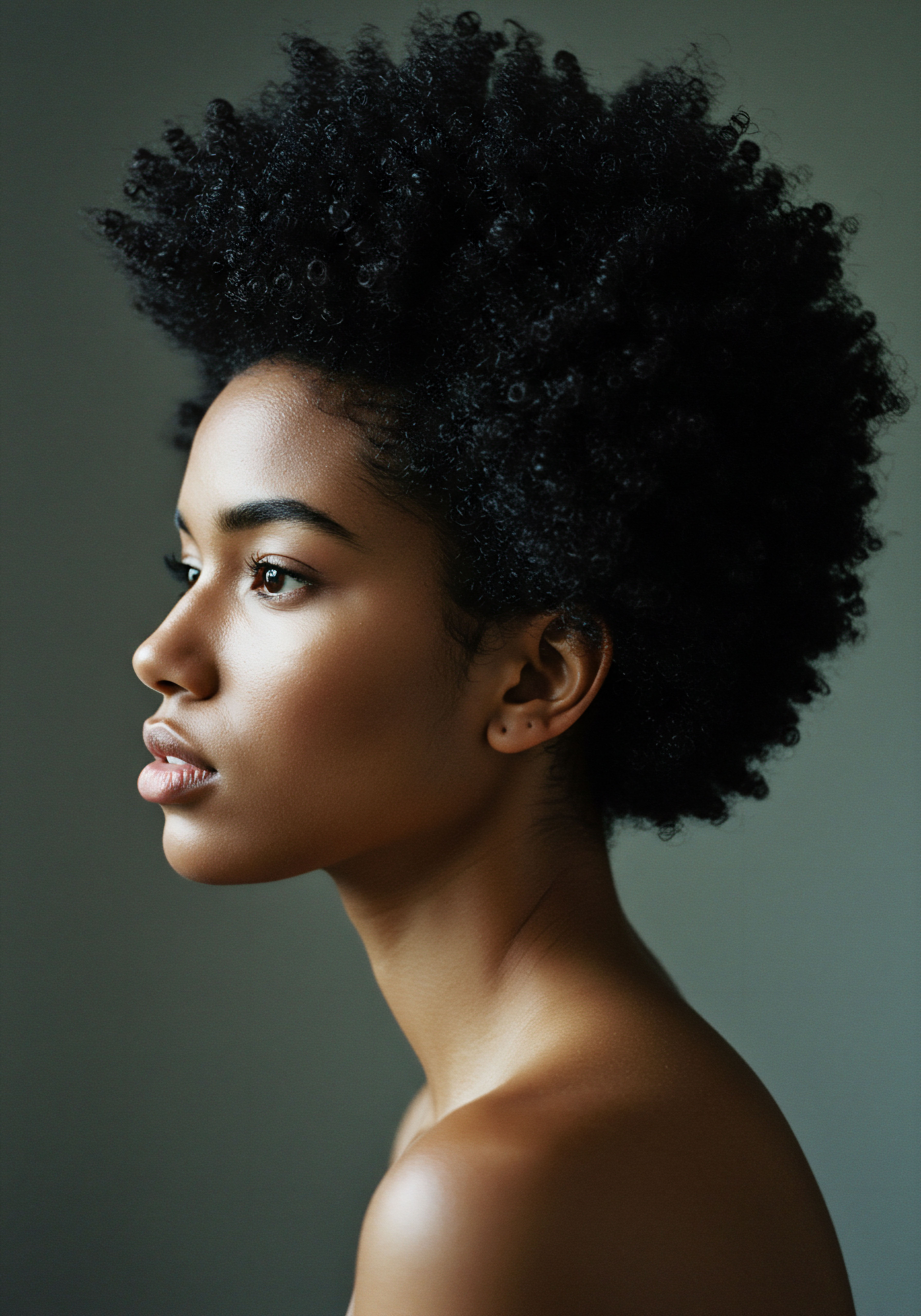
Roots
The quest for understanding the hair on our heads often begins with a whisper of curiosity, a gentle pull towards the very foundations of what makes our strands unique. For many with textured hair, this quiet questioning frequently turns to the impact of chemical relaxers, particularly the delicate scalp that serves as the genesis of each strand. The surface question, “Can hair relaxers cause permanent scalp damage?”, while seemingly straightforward, opens a deeper conversation, inviting us to examine the very ground from which our hair grows. This exploration considers not just the visible alterations, but the unseen transformations beneath the surface, tracing the path from application to potential long-term consequences.

The Scalp’s Delicate Architecture
The scalp, often overlooked in the broader discussion of hair care, represents a complex ecosystem, a living canvas for our hair’s expression. Its layers, from the outermost epidermis to the subcutaneous tissue below, house the hair follicles, each a tiny factory responsible for producing a single strand. A healthy scalp maintains a delicate balance, a protective barrier against external aggressors and a nourishing environment for robust hair growth. When this balance is disturbed, particularly by potent chemical agents, the consequences can extend beyond temporary discomfort, reaching into the very core of follicular health.
The structure of the scalp includes several critical components:
- Epidermis ❉ The outermost layer, acting as a primary protective shield.
- Dermis ❉ Positioned beneath the epidermis, this layer contains blood vessels, nerves, and hair follicles, providing essential nutrients and structural support.
- Subcutaneous Tissue ❉ The deepest layer, composed of fat and connective tissue, offering insulation and cushioning.

How Chemical Relaxers Alter Hair Structure
Hair relaxers, at their fundamental level, function by altering the very chemical composition of the hair shaft. They are designed to break the disulfide bonds, which are the strong linkages responsible for the natural curl pattern of textured hair. This process, known as lanthionization, permanently changes the hair’s shape, rendering it straighter. The primary active agents in these formulations are typically strong alkalis, such as sodium hydroxide, often referred to as lye, or guanidine hydroxide in “no-lye” variants.
The effectiveness of a relaxer stems from its ability to penetrate the hair’s cuticle and cortex layers. Once inside, the alkaline solution reacts with the hair’s protein structure, specifically keratin, breaking those disulfide bonds. This chemical alteration weakens the hair, making it more pliable and amenable to straightening. While this chemical transformation achieves the desired aesthetic, it inherently introduces a vulnerability to the hair fiber, leaving it in a more fragile state.
Hair relaxers fundamentally change hair’s natural curl by chemically breaking strong disulfide bonds, a process that inherently weakens the hair shaft.

Understanding the Chemistry of Relaxation
The chemical process behind hair relaxation is a powerful one, relying on high pH formulations to achieve their straightening effect. Lye-based relaxers, containing sodium hydroxide, are particularly potent, operating at a very high alkaline pH, often between 12 and 14. This extreme alkalinity is what allows for the rapid and effective breaking of hair bonds.
No-lye relaxers, while often perceived as gentler, still utilize strong alkaline agents like guanidine hydroxide, which is formed by mixing calcium hydroxide and guanidine carbonate. While they might cause less immediate burning sensation for some, they can still lead to significant scalp irritation and damage.
The impact of these chemicals extends beyond the hair itself. The scalp, being skin, is susceptible to the caustic nature of these alkaline solutions. When relaxers are applied, particularly if they come into direct contact with the scalp or are left on for too long, they can cause a range of immediate reactions.
These can include a tingling sensation, burning, pain, redness, and even chemical burns. These immediate reactions are critical indicators of the scalp’s distress and can pave the way for more persistent issues.

Ritual
Moving beyond the foundational understanding of hair relaxers, we arrive at the realm of ritual—the practices, both professional and personal, that shape the application and aftermath of these chemical treatments. For many, the act of relaxing hair is deeply ingrained, a periodic tradition passed down through generations or a consistent step in a beauty routine. This section considers the nuances of this ritual, the common occurrences during application, and the immediate effects on the scalp, which often serve as precursors to more enduring concerns. It acknowledges the lived experience of countless individuals who have felt the tell-tale tingle, the warmth, or even the sharp sting that accompanies this transformation.

Immediate Scalp Reactions to Relaxers
The immediate reactions of the scalp to chemical relaxers are varied, yet frequently reported. Many individuals experience a tingling or burning sensation during the application, which is often considered a normal part of the process by users, a sign that the product is “working.” However, this sensation is often an indicator of irritation, a direct consequence of the strong alkaline chemicals coming into contact with the delicate scalp skin.
Studies have documented a range of acute dermatological manifestations. These include:
- Pain and Desquamation ❉ A feeling of discomfort and visible flaking or shedding of the scalp’s outer layers.
- Erythema ❉ Redness of the scalp, a common sign of inflammation.
- Chemical Burns ❉ Depending on the product’s strength, application technique, and duration, relaxers can cause first, second, or even third-degree chemical burns. These burns can be minor, affecting only the top layer of skin, or more severe, damaging deeper layers and potentially leading to bleeding and blistering.
- Inflammation ❉ A general response of the body’s immune system to irritation or injury, often accompanying burns and other scalp issues.
One particularly concerning aspect is that even “no-lye” relaxers, despite their milder perception, have been reported to cause scalp burns as frequently as lye-based ones. This highlights that while the chemical composition differs, the potential for acute scalp trauma remains significant across various relaxer types. The notion that a slight burning sensation is acceptable can mask serious underlying irritation, leading to continued use despite visible damage.
Immediate scalp reactions to relaxers, from tingling to severe burns, are frequent, even with “no-lye” formulations, underscoring the chemical’s potency.

The Progression of Scalp Damage
When the scalp experiences repeated chemical insult, the initial acute reactions can pave the way for more persistent and concerning conditions. The protective barrier function of the scalp, which safeguards against moisture loss and external irritants, can become compromised. This vulnerability can lead to chronic dryness, itching, and increased susceptibility to infections.
One of the most significant long-term concerns related to relaxer use is the potential for hair loss. This can manifest in various forms:
| Type of Hair Loss Telogen Effluvium |
| Description Temporary shedding of hair, often triggered by severe scalp irritation or trauma, pushing hair follicles into a resting phase prematurely. |
| Type of Hair Loss Anagen Effluvium |
| Description More severe hair loss where hair sheds during its active growth phase, often associated with very harsh chemical exposure. |
| Type of Hair Loss Traction Alopecia |
| Description While not directly caused by relaxers, weakened hair and scalp from relaxer use can make the scalp more vulnerable to hair loss from tight styling practices. |
| Type of Hair Loss Cicatricial Alopecia |
| Description A more severe and permanent form of hair loss characterized by scarring of the scalp, which destroys hair follicles. |

Does Scalp Burning Mean Permanent Damage?
The question of whether scalp burning during relaxer application directly translates to permanent damage is complex. While not every instance of burning leads to irreversible harm, repeated or severe burns significantly increase the risk. When chemical burns are deep enough to destroy the hair follicle, the resulting hair loss is permanent, often presenting as a type of scarring alopecia.
A specific condition often associated with chemical relaxer use, particularly in women of African descent, is Central Centrifugal Cicatricial Alopecia (CCCA). This form of scarring alopecia results in permanent hair loss, typically starting at the crown and spreading outwards. While the exact cause of CCCA is complex and likely multifactorial, chemical relaxers are considered a significant contributing factor, particularly when scalp burns or chronic inflammation occur. The insidious onset of CCCA and its correlation with scalp burns from hair relaxers warrants close attention and further investigation.
Beyond visible hair loss, persistent irritation and inflammation can also compromise the overall health of the scalp. This can lead to a cycle of discomfort, dryness, and a weakened barrier, making the scalp more susceptible to other dermatological conditions.

Relay
Our discussion now turns to the broader implications, extending beyond the immediate physical reactions to consider the intricate interplay of historical context, societal pressures, and systemic issues that have shaped the relationship between textured hair and chemical relaxers. This section endeavors to connect the individual experience of scalp damage to a larger narrative, exploring how cultural currents and scientific understanding converge to paint a more complete picture of the potential for permanent harm. It seeks to provide a profound understanding, drawing on research and cultural insights to analyze the complexities of scalp damage from multiple perspectives.

The Historical and Cultural Context of Relaxer Use
The story of hair relaxers is deeply intertwined with the history of Black hair and identity. For centuries, textured hair has been a symbol of heritage, social status, and personal expression in African cultures. However, with the transatlantic slave trade, a damaging narrative emerged, associating “good hair” with Eurocentric textures – softer, smoother, and straighter – while devaluing natural Black hair as “bad” or “unruly.” This societal pressure for assimilation led to widespread adoption of hair straightening methods.
The first chemical relaxer was created by Garrett Augustus Morgan in 1909, initially to ease friction on sewing machines, then adapted for hair. This invention, along with hot combs and other straightening tools, offered a means to conform to prevailing beauty standards. Over decades, relaxers became a common practice, often viewed as a rite of passage for many Black women and girls, a tool for manageability and social acceptance. Advertisements often promoted relaxed hair as “longer, more beautiful, more glamorous,” perpetuating a negative perception of natural textures.
This cultural phenomenon meant that millions, particularly Black women, began using relaxers at a young age, often for decades, unknowingly exposing themselves to potentially harmful chemicals. The societal drive for straight hair often overshadowed any concerns about the burning sensation or irritation, normalizing what was, in fact, a chemical assault on the scalp.

What Are the Long-Term Consequences Beyond Visible Damage?
The question of permanent scalp damage extends beyond immediate burns or visible hair loss, delving into the more insidious, long-term health implications that recent research has brought to light. While chemical burns and alopecia are direct forms of damage, the systemic absorption of chemicals from relaxers presents a different, often delayed, spectrum of concerns.
Recent studies have raised significant alarms about the presence of endocrine-disrupting chemicals (EDCs) in hair relaxers. These include substances like parabens, phthalates, and formaldehyde. EDCs can interfere with the body’s hormonal balance, potentially leading to a range of health issues. The scalp, with its network of blood vessels, can absorb these chemicals, especially when its barrier function is compromised by irritation or burns.
A particularly compelling area of recent research connects frequent relaxer use to an increased risk of certain hormone-sensitive cancers. For instance, a study released in October 2022 revealed that women who used hair relaxers at least four times a year were more than twice as likely to develop uterine cancer than those who did not. This finding from the National Institute of Environmental Health Sciences (NIEHS) Sister Study, which followed nearly 34,000 women aged 35 to 74, highlights a significant, data-backed concern that extends far beyond localized scalp damage. This elevated risk is particularly pertinent for Black women, who are the largest consumers of these products and often begin using them at an early age.
Other potential long-term health associations include:
- Uterine Fibroids ❉ Multiple studies have indicated a connection between early and frequent use of hair relaxers and the development of uterine fibroids later in life, disproportionately affecting Black women.
- Ovarian Cancer ❉ Frequent use of chemical hair straighteners and relaxers has been associated with an increased risk of ovarian cancer.
- Breast Cancer ❉ Some research has linked frequent chemical hair straightener use to a higher risk of breast cancer.
These systemic health concerns underscore that scalp damage from relaxers may not always be visible or immediately apparent. The pathway for these chemicals into the bloodstream, particularly through scalp lesions or compromised skin, raises questions about the broader biological impact. The delayed recognition of these wider health implications emphasizes the need for a comprehensive understanding of relaxer use, moving beyond superficial cosmetic effects to a deeper appreciation of overall wellness.

Professional Application and Safety Protocols
While the risks associated with chemical relaxers are significant, proper application techniques and adherence to safety protocols can help mitigate some of the immediate scalp damage. Professionals are trained to minimize direct contact with the scalp, apply a protective base, and monitor the processing time carefully. However, even with professional application, the inherent caustic nature of the chemicals means that some level of irritation or sensitization can still occur.
The U.S. Food and Drug Administration (FDA) advises caution with relaxers, recommending that users follow all label directions, wear gloves, and avoid applying the product to an irritated or damaged scalp. They also suggest not scratching or brushing the scalp for several days before application. The Modernization of Cosmetic Regulations Act of 2022 (MoCRA) aims to increase the FDA’s power to oversee and regulate hair relaxers, signaling a growing recognition of the need for enhanced consumer safety.
| Measure Patch Testing |
| Purpose To check for allergic reactions or extreme sensitivity to the product on a small skin area before full application. |
| Measure Protective Base Application |
| Purpose Applying petroleum jelly or a conditioner to the scalp and hairline to create a barrier against chemical contact. |
| Measure Avoiding Overlapping |
| Purpose Ensuring the relaxer is only applied to new growth, preventing previously relaxed and weakened hair from being re-processed. |
| Measure Strict Timing |
| Purpose Adhering precisely to the recommended processing time to minimize chemical exposure. |
| Measure Thorough Rinsing |
| Purpose Completely washing out the relaxer with a neutralizing shampoo to halt the chemical process. |
Beyond direct scalp trauma, chemical relaxers carry broader health implications due to endocrine-disrupting chemicals, linked to increased risks of uterine, ovarian, and breast cancers.

Alternatives and a Shift in Perspective
In recent years, there has been a significant shift in the perception of textured hair, leading to a natural hair movement that challenges Eurocentric beauty standards. This movement advocates for embracing and celebrating natural hair textures, offering a powerful alternative to chemical straightening. The decrease in sales of chemical relaxers and the rise of products tailored for naturally curly hair indicate a changing landscape.
This cultural shift also brings with it a greater emphasis on scalp health and holistic well-being. Many individuals are seeking alternative styling methods that do not involve harsh chemicals, such as protective styles, natural styling techniques, and heat-free options. This renewed focus on scalp integrity and overall hair health underscores a broader movement towards self-acceptance and informed choices within the textured hair community.

Reflection
The inquiry into whether hair relaxers cause permanent scalp damage leads us through layers of science, history, and personal experience, revealing a complex truth. It is a truth that acknowledges the immediate, often painful, physical reactions to potent chemicals, and extends to the quieter, more insidious long-term health concerns that have only recently come into clearer focus. The journey through the history of textured hair care shows us how deeply intertwined beauty standards can become with personal health, urging a thoughtful re-evaluation of practices once considered commonplace.
As we consider the future of hair care, the emphasis moves towards celebrating inherent beauty while prioritizing the delicate balance of scalp and systemic well-being. This ongoing conversation is not just about hair, but about informed choice, self-acceptance, and the profound connection between our heritage and our health.

References
- Afolabi, T. & Adigun, A. (2020). Effects of Chemical Straighteners on the Hair Shaft and Scalp. International Journal of Trichology, 12(6), 241–248.
- Shetty, P. et al. (2013). Clinical and Dermoscopic Study of Hair and Scalp Changes in Women Using Hair Relaxers. Indian Journal of Dermatology, Venereology, and Leprology, 79(6), 779-784.
- Kaur, S. et al. (2002). Deep Seated Staphylococcal Infection Related to Usage of Hair Relaxers. Indian Journal of Dermatology, Venereology, and Leprology, 68(2), 101-102.
- Wise, L. A. et al. (2012). Hair Relaxer Use and Risk of Uterine Leiomyomata in African American Women. American Journal of Epidemiology, 175(11), 1100-1109.
- Rigano, L. (2012). Formula Anatomy Deciphered—Hair Relaxers and Straighteners. Cosmetics & Toiletries, 127(11), 740-745.
- Reid, E. E. & Khumalo, N. P. (2014). Scalp Irritation From Hair Care Chemicals. Cosmetics & Toiletries, 129(4), 44-48.
- Khumalo, N. P. et al. (2007). Central Centrifugal Cicatricial Alopecia ❉ Clinical and Histological Features. Journal of the American Academy of Dermatology, 57(3), 450-456.
- Cheek, A. (2023). What Every Dermatologist Must Know About the History of Black Hair. Dermatology Times, 44(12), 24-27.
- White, L. (2011). The oppressive roots of hair relaxer. The Commonwealth Times, 93(16), 11-12.
- Collins, P. H. (2004). Black Sexual Politics ❉ African Americans and the New Racism. Routledge.
- Morgan, G. A. (1913). Hair-Straightening Compound. U.S. Patent 1,068,092.
- Robinson, L. A. (2017). The Science of Black Hair ❉ A Comprehensive Guide to Textured Hair Care. The Science of Black Hair LLC.
- Howard, M. (2019). Hair Story ❉ Untangling the Roots of Black Hair in America. St. Martin’s Press.
- Slomiany, B. L. & Slomiany, A. (2003). Barrier Function of the Scalp ❉ The Role of Ceramides. Skin Pharmacology and Physiology, 16(5), 263-269.
- James, K. (2021). The Evolution Of The Natural Hair Movement. Refinery29.